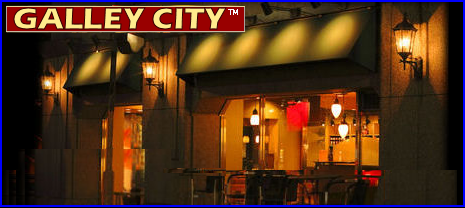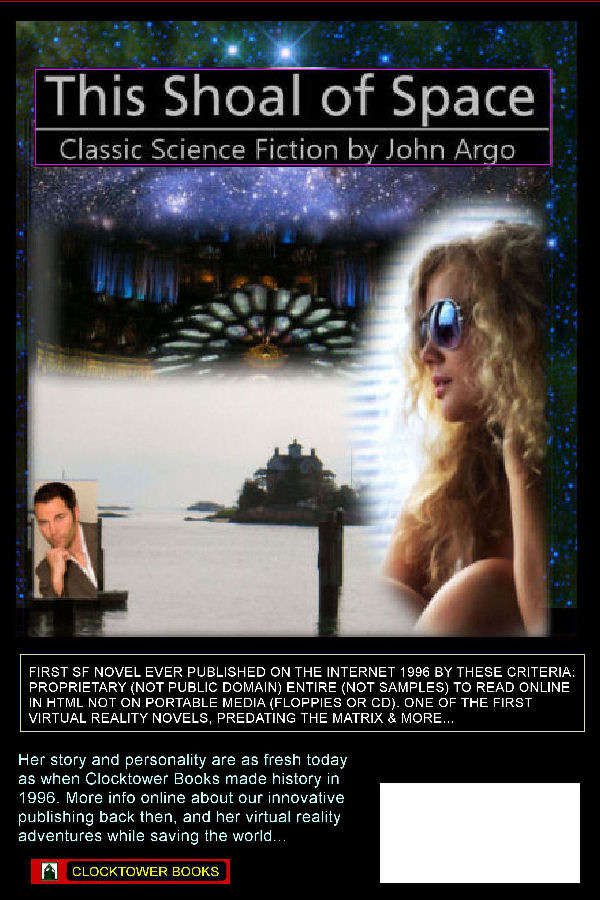|

This Shoal of Space
Early Virtual Reality Novel 1990 pre-Matrix [*]
Virtual Ghosts of an Alien Invasion Gone Wrong in the Age of Dinosaurs
Heartbreaker. Published online in 1996, John Argo's novel tells the story of a young reporter named Zoë Calla, in a small California coastal town, who uncovers a plot to conquer the world. During the dinosaur age, an alien invasion fleet came to earth, but its ships burned up in orbit. One plunged into the sea, where its computer core is now trying to reassemble the ship and resume the invasion. Already it's got strange avatars living in Zoë's brain, and weird events happening across town. Retitled This Shoal of Space in 1998. Later title tries included Woman in the Sea and Starlight Deep Within a Gothic Sea.
Museum Notes by John Argo. I first wrote this novel in the fall of 1990. At the time, I was working with a New York City literary agency, which sent me favorable outside editor review notes (I still cherish them). They unsuccessfully showed it around the city. Close, but no cigar in Myopic City.
Inspiration. I was an avid reader of Jorge Luis Borges, Ray Bradbury, William Gibson, and other great authors whose fantasy fiction often played loose with reality. The most immediate source of my inspiration came from a conversation around 1982 with two young programmers (great fellows) in the bowels of the mainframe world at Yoyodyne (I won't name the real dinosaur corporation). They described something called Virtual Paging, used to swap in program code and data files on a typical mainframe of the time: bigger than a brontosaur or apatosaur, with a brain (RAM, processor memory) smaller than a walnut. That gave me the idea for writing simulated reality or virtual reality fiction (for all I care, it can be Stimulated Reality or Symbolic Reality or Emulated Reality or any other trope).
It just now occurs to me to add that I enjoyed the SF film Tron (1982), which coincidentally is dated same year as my all-time favorite movie Blade Runner (not VR, 1982, dir. Ridley Scott, based on a Philip K. Dick novel). By the way, Blade Runner is my prototype model for DarkSF (Dark Speculative Fiction), being richly atmospheric, artistic, evocative, intelligent, thoughtful, adventurous without being brutal, gory, or juvenile; and long misunderstood by a lot of overly pompous critics; now recognized by most 'authorities' as one of the top 100 films ever made. Same story with Fritz Lang's 1926 Metropolis, which sailed some rough troglodyte seas amid a hail of rotten tomatoes before a few thoughtful, understanding, senstive souls began to realize Metropolis was/is a masterpiece.
Tracy Eastgate, Under The Covers Reviews (circa 1998) gave it top praise: "A complex, imaginative tale set in a small California coastal town where the every-day touches hauntingly on the fabric of far space." She had more praise, which I'll add here soon.
Snop: A young reporter looking for her big break investigates mysterious zoo murders and stumbles upon an intergalactic invader in a virtual netherworld. Two men hover at the periphery—sinister Det. Vic Lara and handsome curator George Chatfield, each with his own terrible mysteries. The ending is not for the literal-minded—but by today, most people have seen The Matrix and other VR-empowered flicks and can deal with The White Stuff, The Cold Thing, and other concepts expanded upon here. This was one of the first virtual reality SF stories, written originally in 1990 and far ahead of its genre. It's a horror novel in the broad sense, and yet it never technically departs from the strictures of SF. "Five Stars. Outstanding, A definite must read ... a powerful book"--Tracy Eastgate, Under The Covers Reviews "I want to pay you a compliment. Rarely does a book EVER get under my skin or in my subconcious enough to cause dreams of any sort, but I'll tell you what, by time this morning came, I wasn't sure I wanted to go back to sleep or not … lol … I actually had mild nightmares last night … I love it … this is an absolutely awesome book."--Tracy Eastgate, Under The Covers Reviews, in a letter to the author of This Shoal of Space.
Digital Firsts. In 1996, this novel became the world's first digital novel published online in HTML for reading online, without any portable media (CD-ROM, floppies, etc.); further qualifications: it was proprietary (not public domain, therefore Gutenberg irrelevant); and a complete novel (not samples or teasers); and a standard type (not hypertext, but the same sort of sequential novel the New York publishers were issuing for the most part); and it was of a standard length (actually a bit longer at 128,000 words).
Global Fan Base. Brian Callahan and I published it starting July 1996 at our second website (The Haunted Village in innovative weekly serial chapters. I would post the next sequential chapter every Sunday evening, to be read by eager readers around the world as they arrived at work for their morning coffee or tea. In those days, few had home computers, so most sneaked a little recreational reading at work. Publishing in San Diego, we received raves from readers across the U.S. and as far away as New Zealand, Germany, South Africa, Canada, and other far-flung locations.
Originally published in 1996 as Heartbreaker, John Argo retitled the novel This Shoal of Space in 1998. Brian Callahan, co-publisher at the time, did the first covers and all web design.
Bestseller. This novel became a bestseller at the original Rocket eBooks and Barnes-Noble websites, and later at Fictionwise, where it had nearly 500 ratings, about 90% of them Great or Good.
Virtual Reality. Among the original themes in this novel was the idea of Virtual Reality (years before films like The Matrix or Inception, although we make no claim for first place—unless you consider that the VR in this novel involves arrayed microcomputers (PCs), actually laptops in effect, which were new at the time (I owned an early Toshiba). I first encountered the concept of virtual paging as a technical writer working at a major aerospace firm in San Diego. When some mainframe programmers explained the concept to me, my agile SFnal mind immediately conjured what would become known as virtual reality. Ray Bradbury gets at least early credit for the concept with his short story The Veld in the 1950s, but I was having a lot of creative fun. That's what counts. The notion of arrayed computers also comes into play (read the novel, please).
[*] Further History Notes: VR. Virtual Reality (VR) and similar names apply to a story type that became popular with the film The Matrix 1999, which I found enjoyable; but I was already there with This Shoal of Space (written 1990, published online 1996 original title Heartbreaker at The Haunted Village (too early for the Wayback Machine; hosted by the original Electriciti on India Street in San Diego). While I invented my own trope, I am quite conscious, however, that VR (or whatever you want to call it) was already there long ago. At least as early as 1950 with Ray Bradbury's brilliant (Saturday Evening Post) short story The Veldt. I would suggest also that VR is a strong component of the work of Argentine author Jorge Luis Borges, whom I greatly admire; just one example being The Circular Ruins. The history of this parallel-reality fiction goes far back, to be sure. I commend This Shoal of Space to you as a wholly original artistic creation that, once it has been done being ignored, will appeal mainly to those same consumers (like myself) who, for example, fell in instant, life-long love with Blade Runner sitting in a SoCal movie theater in 1982. You either get it or you don't; no big deal. Hold the rocks and rotten tomatoes. I am very happy with what I have created. [JTC]
TOP
|


|
What is DarkSF? DarkSF is the Dark Chocolate of Science Fiction. DarkSF is not about gore or grue but about art and atmosphere. It is literary and poetic. Think of the artful genius of Ridley Scott's 1982 Blade Runner or Alex Proyas' 1998 Dark City or Julien Leclercq's 2007 Chrysalis, just to name three. The best SF is DarkSF because it tends to embrace sweeping themes in a rich broth of art and atmosphere. The list is long, and includes far more of world literature than our Puritanical society is allowed to think. Elements occur in the Epic of Gilgamesh, Homer's Iliad and Odyssey, Dante's Divine Comedy, Defoe's 1719 Robinson Crusoe, and tales by many modern masters. We'll be publishing a special DarkSF website soon to celebrate.
|
|
Clocktower Books Museum Pages. You can read more about all this at the Clocktower Books Museum pages. It's also preserved in the last iteration of The Haunted Village SFFH. Remember, this was before e-commerce, so we published my work for free (promotionally, as Karen Wiesner described it in her history about all this). Check out this Wayback Machine page (screen capture before squatters bought CTF and turned robots off in hope of extorting money; no such luck, trogs): The Wayback Machine entry for CTF dated 9 January 1998 states that we already had over 250,000 words of original fiction by John Argo online by that time—dating to our first websites published in early to mid 1996. Brian Callahan and I were two busy guys in the 18 months before 9 Jan 1998. All of that was my own fiction (John Argo). As a history (nonfiction) writer, I love learning about the past so I can understand the present and glimpse the future. As a true SF writer, I will pilot my keyboard toward the sunrise and tomorrow.
|
|
|
|
Browse or Buy at Amazon
The book linked at left is an e-book edition to browse; or buy & download from Amazon for your Kindle reader.
The middle link is for the corresponding print edition. Most of these are standard 6x9"; a few have added trim sizes available (5x8"). More info at Amazon.com.
Most print editions are also available at Barnes & Noble online; or call/visit your local bookstore to order.
|
|